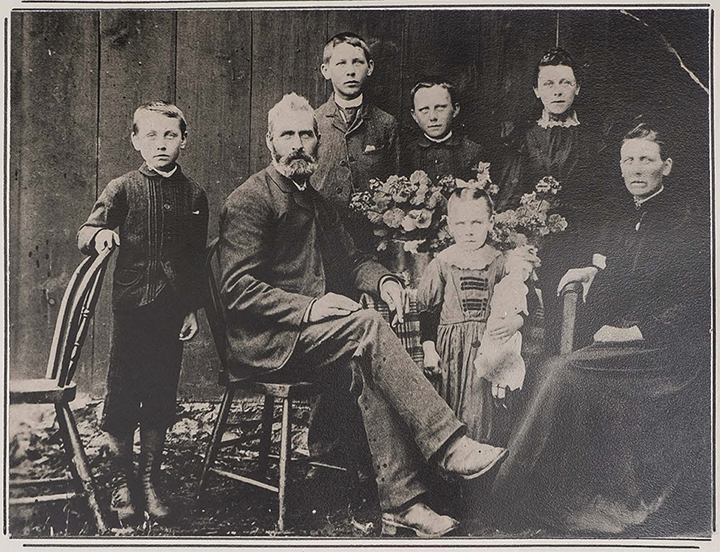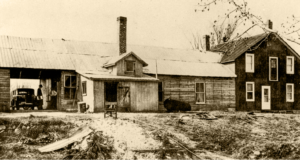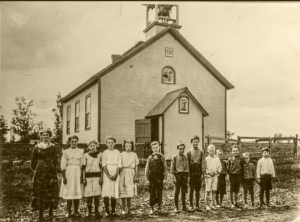The Communities of Rideau
Unless otherwise noted, all content is the property of, and used courtesy of the Rideau Branch, City of Ottawa Archives, North Gower.
Watterson's Corners
A BRIEF HISTORY OF WATTERSON'S CORNERS
By Monta Kerr August 1991
The Wattersons
Watterson’s Corners, located at the intersection of First Line and Century Roads, southwest of Manotick, was initially little more than an intersection of Watterson properties. When it was first settled, the land was covered with dense bush, a major obstacle for the hardy pioneers who tried to tame it.
Noble Watterson arrived in North Gower Township in the 1840s or early 1850s. He was anxious to make a new life for his wife Isabella, and their seven children. But he had decided to visit Canada and survey the land before taking the final step of sending for Isabella and the children. As the story goes, he finally did send word for his family to join him, around 1851,but not knowing when they would arrive, he went away to visit friends in Maine. As it happened the Watterson family arrived at Lindsay’s wharf in Kars when Noble was out of the country! So there they were, Isabella and seven children, filled with hopes, expectations, and probably more than a little anxiety: They had arrived in a strange new land to find their father missing. Fortunately a local family took them in until Noble returned.
Life improved for the Watterson clan. Noble bought one hundred acres of excellent farmland and began clearing. He and Isabella settled there, along with their seven Irish-born children William, James, Gabriel, Robert, Noble Jr., John and Elizabeth, and two others born in Ontario, David and Mary. (There has been mention of a tenth Watterson child, a girl, who may have died or married in Ireland.) Gabriel, James, William, Robert and David eventually all had land nearby, and their farms, along with their father's, formed Watterson’s Corners.

Early Settlers
However, the Wattersons weren't the only family who settled in this area. Names like James Griffith, Adam Gaddis, Samuel Potter, Robert Brown, Henry Mitchell, Samuel Duncan, and John Bell all show up in the early records of the Watterson’s Corners area. It seems there was also a carding mill and loom nearby, which was owned by two brothers called James and William Miller. The mill was destroyed by fire sometime around 1950 (?).
John Bell Wilson arrived here from Carp in 1892. He reported bad roads and, not surprisingly, no telephones in the area during the early years. Communication with the outside world was not easy for the farmers. People wanted news; understandably, they were tired of being cut off from everyone else. John Bell Wilson travelled to Ottawa and asked Prime Minister Robert Borden to establish a post office at Watterson’s Corners. Within two weeks, no one had to make the voyage to Manotick for the mail anymore. It was delivered to Robert Watterson's home. The first post office was run by Robert's daughters.
Watterson’s Corners developed to serve the needs of the farmers. It reflected their changing requirements, and as the area became more settled, the services improved.
A small industrial/commercial core grew up around the cheese factory that once stood in Watterson’s Corners. The Kidd No. 5 Cheese Factory (later called the First Line Cheese Factory) was built in 1908, by Carleton MPP Edward Kidd. He built it on Mud Creek, long before the days of environmental awareness, so the wastewater could be washed into the river. When Edward died in 1913, Thomas J. Hicks bought the factory. He kept it until 1922 when he left to pursue a lifetime career in the cheese industry with provincial and federal agencies.
There was briefly a golf course at Watterson’s Corners in the late 1920s. A Mr. M.J. O'Brien sold shares at $100 each to help build the Twin Elms Golf Course on what is now Periwinkle Hill Farm. He had a grand opening in September 1929, but by the following spring he had gone bankrupt and left the area. The golf course was closed, and investors lost their money. The farm, which had belonged to the Mitchells, returned to them. Except for memories and a few summers of "barnyard golf" the golf course was no more.
Back to the cheese factory, Francis Lewis owned it while the golf course was there. In 1930, he sold the factory to Gerald Stewart.
Early one morning in 1934, Gerry Stewart went down the road to light the fire for the boiler, then went home for breakfast, as he always did. When he returned to start his workday, he found the factory ablaze. Nothing was saved from the ravaging flames. However, the cheese factory was not the sole enterprise in Gerry Stewart's life. He had re-named Watterson’s Corners after a place in Florida called Periwinkle. He had spent his winters working as a bellhop in Florida and his summers in Watterson’s Corners. Besides the cheese factory, Gerry also ran a take-out restaurant where he sold light lunches and snack food.
After the cheese factory burned down, Gerry left Watterson’s Corners. The next two years were difficult for the farmers, because they had become dependent on the cheese factory. To fill the need, Kemptville Creamery picked up the milk from some of the farmers, while others sent milk to nearby cheese factories.
In 1936, the farmers found their saviour in a man named George Elmer Thompson. He agreed to operate the factory and had his own factory moved from Prospect, Ontario. While Elmer owned it, the cheese factory was more productive than it ever had been. Elmer also went on to develop a number of entrepreneurial ventures at Watterson’s Corners. He set up a gas station, general store, farm equipment dealership, home appliance outlet, farm equipment and auto repair service centre, and a car and truck dealership. In fact, Thompson's Shopping Centre was once advertised as the largest independent farm shopping market in the Ottawa Valley.
In 1945, Elmer sold the cheese factory to his brother-in-law, Wilbur Saunders.. After fire destroyed the entire factory and the equipment in 1951, Wilbur decided not to rebuild, and that marked the end of the cheese factory era in Watterson’s Corners. Wilbur's house was saved but all that remains of the once-prosperous factory is a concrete floor slab along the banks of Mud Creek.
But Watterson’s Corners remains. Some of Elmer Thompson's commercial ventures are still there, although changes have been made. The tiny centre still serves area residents, and, despite rapid modern communications, retains the farming spirit of the First Line.
References:
Cheese Factories of Rideau Township, by Iona Joy. Kars on the Rideau, by Coral Lindsay.
St. James Anglican Church Centennial History.
Mr. Jim McNeice, Kars Mrs. Jean Montabone, First Line Road Mrs. Rita Nixon, First Line Road


